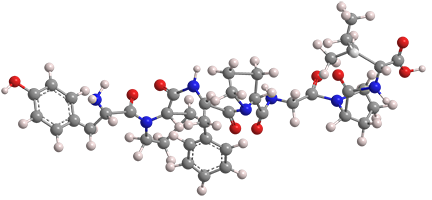What molecule am I?


Casomorphins are peptides formed by the enzymatic breakdown of the milk protein casein during digestion. The peptides typically contain from three to eight amino acids.
Casein in milk produced by mammals occurs in three main forms: α, β, and κ. Cows’ milk contains only β-casein (β-CN), which occurs in several genetic variants; the most predominant are A1 and A2. The casomorphins derived from β-CN also carry the β designation and are further labeled by the number of amino acids they contain.
Bovine β-casomorphin 7 (BCM-7) is released by the A1 form of β-CN during digestion or cheese making, but not by A2. Three of its seven amino acids are proline. (See the abbreviation table for the names of all of the amino acids.) According to a 2022 article by Cristina Lamberti and colleagues at the Institute of Sciences of Food Production (Bari, Italy), “BCM-7 is a known μ-opioid receptor agonist that may influence the gastrointestinal physiology directly and may also exert effects elsewhere in the body, such as on the cardiovascular, neurological, and endocrine systems.”
Lamberti et al. sought to revise earlier reviews on BCM-7 ingestion with a focus on its effect on health-related outcomes. Their principal conclusion was “that A2 β-CN exerts beneficial effects at the gastrointestinal level compared with A1 β-CN, but that there is no evidence of A1 β-CN having negative effects on human health” resulting from the release of BCM-7.
BCM-7 can be isolated as a powder. It is hygroscopic and must be protected from light; and it should be stored at –20 °C.
Bovine β-casomorphin 7 hazard information
| Hazard class* | GHS code and hazard statement |
|---|---|
| Acute toxicity, oral, category 5 | H303—May be harmful if swallowed |
| Acute toxicity, dermal, category 5 | H313—May be harmful in contact with skin |
*Globally Harmonized System (GHS) of Classification and Labeling of Chemicals.
MOTW updates
Salvinorin A1 (SalA) was the Molecule of the Week for May 21, 2012. It occurs in Salvia divinorum and has been reported to be the most potent naturally occurring hallucinogen. Since its discovery, chemists have looked for ways to use SalA as a source of beneficial drugs because activation of this receptor is not noted to produce addictive effects.
Last month, Bhawyanth Duvvuru and Myles W. Smith* at UT Southwestern Medical Center (Dallas) reported on ways that SalA can be “salvaged” by using innovative chemical methods. They cite the work of Ryan A. Shenvi, Laura M. Bohn, and co-workers at Scripps Research (Jupiter, FL, and La Jolla, CA), who developed a short asymmetric synthetic method for accessing what they call “a focused library of salvinorins”.
Barium sulfate2 (BaSO4) was the MOTW for January 21, 2008. Also known as barite, the mineral in which it is found, its principal use is as a densifying additive to oil well drilling fluids, or “muds”.
BaSO4 works well in petroleum drilling muds; but it can be problematic for drilling in other reservoirs such as shale oil and gas deposits, where it widely contributes to mineral scaling despite the use of scale inhibitors. In August, Barbara F. Esteves*, Jennifer L. Druhan, and Adam D. Jew at the University of Illinois at Urbana–Champaign and the SLAC National Accelerator Laboratory (Menlo Park, CA) used experimentation and modeling to improve the understanding of the geochemical behavior of BaSO4 accumulation in shale matrices under conditions typical of fracturing operations. Their experiments demonstrated a pH dependence on the rate of BaSO4 precipitation, which they incorporated into a predictive model that they validated on three major shale samples of highly variable mineralogy.
1. CAS Reg. No. 83729-01-5.
2. CAS Reg. No. 7727-43-7.
This molecule was suggested by a reader. We present almost all of the molecules suggested by our readers. If you have a molecule you would like us to consider, please send us a message. And thank you for your interest in Molecule of the Week! —Ed.
Amino acid abbreviations
| Abbreviation | Amino acid |
| Gly | Glycine |
| Ile | Isoleucine |
| Phe | Phenylalanine |
| Pro | Proline |
| Tyr | Tyrosine |
Bovine β-casomorphin 7
fast facts
| CAS Reg. No. | 72122-62-4 |
| SciFinder nomenclature | L-Isoleucine, L-tyrosyl-L-prolyl-L-phenylalanyl-L-prolylglycyl-L-prolyl- |
| Empirical formula | C41H55N7O9 |
| Molar mass | 789.92 g/mol |
| Appearance | White powder |
| Melting point | Not reported |
| Water solubility | Soluble |

Learn more about this molecule from CAS, the most authoritative and comprehensive source for chemical information.
Molecule of the Week needs your suggestions!
If your favorite molecule is not in our archive, please send us a message. The molecule can be notable for its current or historical importance or for any quirky reason. Thank you!
Stay Ahead of the Chemistry Curve
Learn how ACS can help you stay ahead in the world of chemistry.

